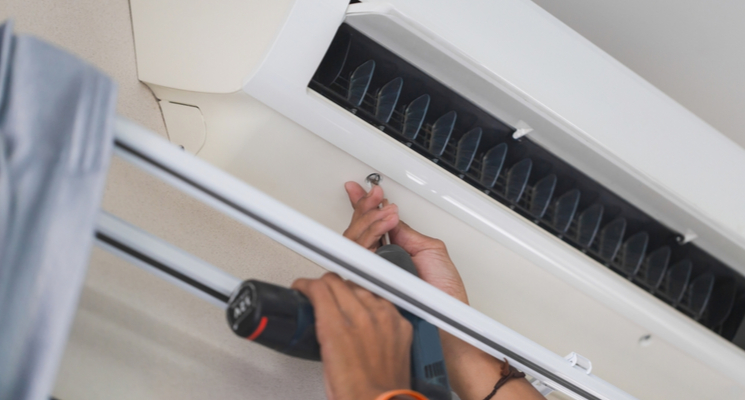The Indoor Unit’s Position:
For even air dispersion and effective cooling, the interior unit must be positioned correctly.
Thumb Rules:
- Elevation above the ground: For the best airflow, place the device 7 to 8 feet above the ground.
- Distance from the Ceiling: For unhindered air intake, keep the distance from the ceiling at least 6 inches.
- Stay away from heat sources: Avoid placing it in direct sunlight or next to heat-emitting appliances.
The device should be positioned to blow air throughout the room’s longest dimension. To avoid water damage in the event of condensation leaks, keep it away from delicate electronics. In addition to improving cooling effectiveness, proper positioning guarantees user comfort.
Positioning of Outdoor Units:
An essential component of the system’s overall effectiveness is the outside unit, which houses the compressor and condenser. Protection and ventilation should be given first priority while placing it.
Thumb Rules:
- Level Surface: To avoid vibrations, place the device on a level, sturdy surface.
- Ventilation: For adequate ventilation and heat dissipation, make sure there is at least two feet of space on all sides.
- Shade: Use a canopy or shade to shield the device from direct sunlight.
- Distance: To preserve efficiency, keep the distance between interior and outdoor units to no more than 15 meters.
To avoid water damage during rainy seasons, mount the outdoor unit just above ground level. Wear and noise can be decreased with anti-vibration pads. Placing outdoor units correctly increases cooling efficiency and prolongs system life.
The Power Supply And Electrical Wiring:
A steady power source and appropriate electrical wiring are necessary for the AC unit to operate safely and effectively.
Thumb Rules:
- Dedicated Circuit: To avoid electrical overloads, use a dedicated circuit.
- Accurate Rating: Circuit breakers and wires should be matched to the AC’s power rating (for example, a 1.5-ton AC might need a 15A circuit).
- A voltage stabilizer: To safeguard the unit, install a stabilizer in locations where voltage swings occur frequently.
To prevent electrical risks, make sure the earthing is done correctly. For longevity and security, use premium wire materials. Proper electrical configuration prolongs the AC unit’s lifespan and prevents failures.
Airflow and Ventilation:
Sufficient ventilation guarantees that the air conditioner runs well without overheating or putting undue load on it.
Thumb Rules:
- Make sure you don’t block any air vents or intakes, whether they’re interior or outdoor.
- Keep the outdoor unit at least two feet clear on all sides to provide adequate ventilation.
To maintain ideal circulation and avoid dust buildup, clean the indoor unit’s air filters on a regular basis. Energy consumption is decreased and cooling efficiency is increased with proper ventilation.
The Thumb Rule for Sizing Air Conditioners:
HVAC technicians and engineers have long relied on a rough rule of thumb when estimating the square footage needed to meet the cooling demands of various eras. This approach yields accurate findings sometimes and inaccurate outcomes other times. Because they are quick and simple, the air conditioner sizing thumb rule is typically applied when temporary cooling is needed. The air conditioning system’s size is determined by the thumb rule, which employs 500 square feet per ton.
Few alternative load calculator methods may turn out to be more accurate than the thumb rule for figuring out the proper size of your air conditioning system, despite the fact that HVAC businesses utilize it extensively.
Sizing Ton-for-Ton:
Another quick and simple technique for precisely estimating the size of a temporary cooling system is ton-for-ton sizing. The process involves figuring out how big the current air conditioning system is and then swapping it out for a temporary cooling system that is the same size. Unless the space’s design and occupancy change, or if the prior system wasn’t able to provide enough cooling, this method doesn’t require any additional calculations.
When using the ton-for-ton approach to determine the size of an air conditioner, minor adjustments shouldn’t result in many issues. However, adjustments like raising or lowering the cooling load might cause serious issues with the air conditioner, necessitating regular AC repair. This approach is typically employed when there isn’t enough time for a more thorough calculation methodology and the area needs air conditioning installed or replaced right away.
Frequently Asked Questions:
1. Is It Possible To Modify Refrigerant Piping For Non-Standard Installations?
It is possible to modify refrigerant piping to meet specific installation needs, such as those involving large distances or limited space. A custom design can still be efficient if it takes into account the system’s compatibility, pipe insulation, and pressure drops of the refrigerant. For effective customisation, it is essential to get advice from a professional.
2. How Is The Distribution Of Refrigerant Handled By Multi-Split Air Conditioning Systems?
Multiple indoor units can function independently in a multi-split system because the distribution of refrigerant is controlled by a network of branch pipes and valves. All units must adhere to the same standards for pipe sizing, insulation, and pressure regulation in order to keep running efficiently. A well-balanced flow of refrigerant is guaranteed by expert design and installation.
3. What Is The Average Pipe Lifespan Of An Air Conditioner And How Is It Possible To Make It Last Longer?
Air conditioner piping has a lifespan that is affected by factors like material quality, how it is installed, and how often it is maintained. Although aluminium pipes might not survive as long as copper ones, copper pipes usually endure around fifteen to twenty years. The lifespan of refrigerant piping can be greatly increased with regular inspections, protective coatings, and suitable insulation.

